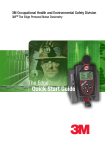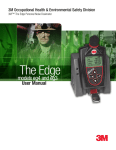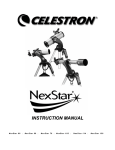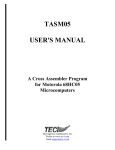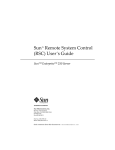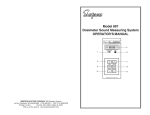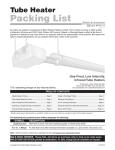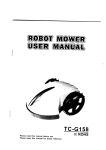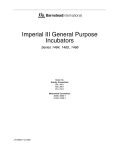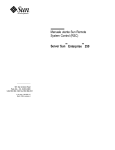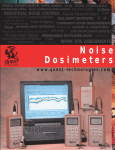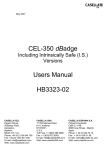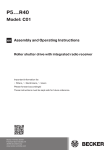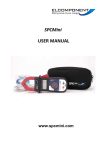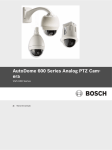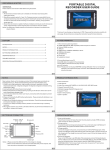Download TABLE OF CONTENTS - Pdfstream.manualsonline.com
Transcript
TABLE OF CONTENTS INTRODUCTION……………………………………………………………………………………….3 M-27 SIMPLIFIED OPERATING INSTRUCTIONS…………………………….…………………..5 Control Keys…………………………………………………………………………..……..5 Sound Level Meter Keys……………………………………………….…………………..6 Dosimeter Keys………………………………………………………………………….…..6 Time Keys……………………………………………………………………………………..7 Event Keys……………………………………………………………………………………7 Procedure to Accumulate Event Data…………………………..……………………….7 Setting the Clock……………………………………………………………..……………..8 Recording the Calibration Level………………………………………………….………8 Using a Printer……………………………………………………………………………….9 Dumping Raw Data……………………………………………..…………….……………11 Changing Printer Parameters……………………………………….……….…………..11 SPECIFICATIONS………………………………………………………………………….…………11 GENERAL DESCRIPTION…………………………………………………………………………..12 PRINCIPLES OF OPERATION……………………………….……………………….…………….13 General……………………………………………………………….………………………13 Weighting Characteristics………………………………………………….……………..13 Microcomputer Modes…………………………………..…………………………………14 Formulas and Definitions……………………………………….…………………………16 TESTING AND CALIBRATION………………………………………………………………………17 Battery Test…………………………………………………………………………………..17 Battery Replacement……………………………………….……………………………….17 Microphone Replacement……………………………………………..…………………..18 Calibration and Maintenance…………………………………………………..………….18 Daily Calibration……………………………………………………………………………..18 Altitude Corrections……………………………………..………………………………….19 OPERATING PROCEDURE…………………………………………………….………………….…19 As a Personal Noise Dosimeter……………………..……………………………………19 As an Area Monitor………………………………………………..………………………..20 As a Survey or Event Monitor…………………………………………….………………21 Effects of Operator's Presence……..……………………………………………………22 Use with Windscreen……………………………………………………………………….22 Using a Printer……………………………………………………………………………….23 Connections to Printer……………………………………………………………………..24 Sample Printouts………………………………………………………..…………………..24 Memory Map……………………………………………………………………………..…...30 Editing Printout………………………………………………………………………………31 Printer Setup……………………………….…………………………………………………32 EXTENDING BATTERY LIFE………………………………………..……………………………….33 INTERNAL SWITCHES………………………………………………………………..….…………..34 Switch Positions……………………………………………………………………….……36 Setting Internal Switches………………….………………………………………………38 Code Decoding…………………………………………..……………..…………………..41 TROUBLESHOOTING………………………………………………………….…………………….42 INTERPRETING RESULTS………………………………………………………………….………43 Use of Lavg and TWA……………………………………………………………………..43 Estimating TWA from Lavg…………………………..………………………………….44 Accuracy of Readings………………………………………..…………………………..44 Hints and Good Practices………………………………………….…………………….44 Considerations of Measurement and Accuracy…………………..…………………46 ACCESSORIES………………………………………………………………………………..……..47 QUEST SERVICE AND WARRANTY POLICY……………………………………………………48 FCC COMPLIANCE AND CAUTIONARY NOTE: INTRODUCTION User is cautioned that changes or modifications not expressly approved by the party responsible for compliance could void the user's authority to operate the equipment. NOTE: This equipment has been tested and found to comply with the limits for a class B digital device, pursuant to part 15 of the FCC Rules. These limits are designed to provide reasonable protection against harmful interference in a residential installation. This equipment generates, uses and can radiate radio frequency energy and, if not installed and used in accordance with the instructions, may cause harmful interference to radio communications. However, there is no guarantee that interference will not occur in a particular installation. If this equipment does cause harmful interference to radio or television reception, which can be determined by turning the equipment off and on, the user is encouraged to try to correct the interference by one or more of the following measures: -- Reorient or relocate the receiving antenna. -- Increase the separation between the equipment and receiver. -- Connect the equipment into an outlet on a circuit different from that to which the receiver is connected. -- Consult the dealer or an experienced radio/TV technician for help. The QUEST M-27 Noise Logging Dosimeter is a microcomputer-based sound analyzing instrument for accumulating, displaying, and sending data to serial or parallel printers or computers. The M-27 functions as a personal noise dosimeter, an area monitor or as a survey events monitor (see Figure 1). Personal Noise Dosimeter: Accumulates noise data for OSHA hearing conservation, OSHA engineering controls, and equal energy noise dosimetry. Accumulates peak and maximum levels. Accumulates 1-minute histograms and 1 dB statistical distributions. Is housed in a secure dustproof case. May be clipped on belt or shirt pocket. Area Monitor: Accumulates 40 hours of 1-minute histograms and statistical distributions. May be tripod-mounted. Events Monitor: Accumulates the following data for up to 16 separate events: 3 separate integrated sound levels. 3 separate noise doses. 2 time weighted averages and a sound exposure level. Peak level, maximum level, start time, and run time. The M-27 as an overall unit accumulates data for: 3 separate dosimeters. 3 separate 1 minute time histograms. 2 separate percent time statistical distributions. 2 separate percent dose distributions. 16 separate events. Sound levels, peaks and maximum levels. Run time, pause time, and elapsed or real time. The unit displays: Sound level, peak level, maximum level. 2 integrated average levels. An equivalent sound level. 3 percent doses. 2 time weighted averages. A sound exposure level. 16 separate events. Run time, pause time, and upper limit time (the time greater than preset level). Elapsed or real time clock (12 or 24 hour). Calibration level. Code of 24 internal switch settings. The unit prints out: A heading. Summary of accumulated data and setup parameters. Up to 16 separate events. 3 separate 1-, 3-, 5-, or 10-minute time histograms. 2 percent time statistical distributions. 2 percent dose statistical distributions. Raw data for computer storage and manipulations. Includes editing capability to print out only required data. The M-27 internal switches select: Exchange rates of 3, 4, 5, or 6 dB. Criterion levels of 80, 84, 85, or 90 dB. 2 thresholds of none, 70, 75, 80, 85, or 90 dB. 2 ranges of 35-126 or 50-146 dB. "A" or "C" frequency weighting. Fast or slow time constant. Upper limits of 90, 115, or 140 dB. 12 or 24 hour clocks. 8 different unit numbers. Text, graph, or both printouts. Serial or parallel printers. Baud rates of 300, 600, 1200, or 2400. Line feed, carriage return, or both. The above features, packaged in a compact, rugged, hand-size, easy-to-use instrument, make the QUEST M-27 Noise Logging Dosimeter the "Ultimate" dosimeter. M-27 SIMPLIFIED OPERATING INSTRUCTIONS When using the unit gently press key until light click is felt. Hold down until unit responds. Generally this will be immediately, unless the unit is calculating data such as sound level, in which case it may take up to a second. Control Keys RUN PAUSE RESET ON OFF Starts or continues accumulating data. Display shows run time. Also used to start Events. Stops accumulation of data. Display counts down from P-5 to P-l. If key is not released in 5 seconds, unit will reset, and old data will be lost. Key is also used to reset Clock, Calibrator, Events, and pause the Printout. If OFF, press to turn on. If ON, hold key down; display counts down from 0-5 to 0-1 and then blank. When off, data is retained. Key also turns off Print and Events. NOTE Data is not lost when the unit is off. Data will be retained for the life of the battery. The only ways to erase data are to hold down PAUSE/RESET for 5 seconds or to remove the battery. CODE HL3 Cycles through 7 steps. Press the key for each step. Allows the M-27 to display and print data 7 ways. Also displays a code of internal switch settings. Time Keys RUN TIME PAUSE TIME . U.L. TIME In steps 1 to 3 only data for the HTL (High Threshold Level), LTL (Low Threshold Level), or 3 dB (No Thresh-old) will he displayed or printed. In step 4 data for HTL, LTL, and 3 dB will be printed. Step 5 dumps raw data to the Computer. Step 6 reads or resets the Clock. Step 7 reads or stores the Calibrator level. The total time the unit was running and accumulating data. If the total time is less than 30 minutes, the colon will blink if the key is held down and the time shown is in minutes and seconds. If the colon stays on, the time shown is in hours and minutes. The time the unit was on but not accumulating data. The colon blinks as in Run Time The time exposure was above the Upper Limit. The colon blinks as in Run Time. Event Keys The event feature accumulates Lavg/Leq, Dose, TWA/SEL for 3 dosimeters, Peak Level, Max Level, Run Time, and Start Time for up to 15 different events. Each time a key is pressed in the Event mode, the display will show the event number and the data. EVENT Sound Level Meter Keys SOUND Sound Level in decibels. Will repeat each second until LEVEL another key is pressed. To conserve power, press RUN, PAUSE or any other key to exit sound level when it is not needed. Enters Events and cycles through the Events with data. The display shows the event number, a "CE" if it is the Current Event or else a "-E" for a previous Event. As an example: 12CE means 12 is the Current Event, 3-E means 3 was a previous Event. Only previous events with data will be displayed. RUN Starts accumulating data for the Current Event. PAUSE RESET Stops accumulating data and cycles to the next Event. PEAK LEVEL The highest unweighted Peak Level in decibels during Run Time or an Event. In 30 dB range lowest peak ON/OFF Exits the Event mode. MAX LEVEL measurable is 78 dB; in 50 dB range the lowest measurable is 98 dB. The Maximum Level in decibels after the filter and Slow or Fast time constant circuit. Dosimeter Keys L-AVG The average integrated sound level in decibels for the LEQ HTL (High Threshold Level), LTL (Low Threshold Level), or the equivalent level for 3 dB. It is the accumulated sound averaged during the Run Time. DOSE The accumulated Dose in percent for HTL, LTL, or 3 dB. TWA SEL Time Weighted Average in decibels for HTL and LTL. It is the accumulated sound averaged over 8 hours. For 3 dB it is the Sound Exposure Level of the accumulated sound averaged over 1 second. Procedure to Accumulate Event Data To enter the Event mode, press EVENT. To accumulate data, press RUN. To stop, press PAUSE/RESET. Press RUN and PAUSE/RESET again to accumulate another event. Press ON/OFF to exit events. The following keys can be used to read data in the current event or in any previous event. CODE Cycles through HTL, LTL, and 3 dB. Displays the curHL3 rent time or elapsed time for the current event and the start time for any previous event. L-AVG LEQ The average or equivalent level for the HTL, LTL, or 3 dB for the event. DOSE The percent Dose for the HTL, LTL, or 3 dB for the event. the CAL screw. If the unit is more than a few decibels out of calibration, it should be rechecked. PAUSE RESET Resets the calibration level. Hold key down until the display shows CAL. TWA SEL The Time Weighted Average for HTL or LTL or the Sound Exposure Level for the event. PEAK LEVEL The Peak Level for the event. MAX LEVEL The Maximum Level for the event. Using a Printer The printout (Figure 2) can include a heading, a summary of the data, event data, 1 to 3 histograms, 1 or 2 percent time statistical distributions, and 1 or 2 percent dose statistical distributions. The histograms can be of 1, 3, 5, or 10-minute duration. The histograms and statistical distributions can be text, graphical or both. The printout can be changed and edited before or during printing to print only desired data. Data is not lost during a printout. RUN TIME The Run Time of the event. CODE HL3 To print only HTL, LTL, or 3 dB histograms and statistical distributions, hold key down until the one desired is displayed. To print all 3, hold key down until all 3 are displayed. PRINT Prints heading, summary, events, and desired histograms and distributions. HIST 1 Prints 1-minute Histograms or 5 minutes per line. If HTL, LTL, and 3 dB are displayed all 3 will be printed. HIST 3 Prints 3-minute Histograms or 15 minutes per line. HIST 5 Prints 5-minute Histograms or 30 minutes per line. HIST 10 Prints 10-minute Histograms or 1 hour per line. Setting the Clock If the clock is not set, it functions as an elapsed time clock from the time the unit is reset. The clock can be either a 12- or 24-hour clock depending on an internal switch. CODE HL3 PAUSE RESET When the clock is set to the current time, it will record the actual time for Events and Histograms. Press until the display includes a colon. The display is in hours and minutes. To set clock, press 0 and numbers for the current time. The time will move in from the right. The clock is not set until PAUSE/RESET is pressed. Resets the current time to the number in the display. The display then shows CLo. Recording the Calibration Level The procedure does not calibrate the unit. It stores the CAL level to assure the unit was calibrated. CODE Press the key until CAL and the current calibration HL3 level is displayed. To recalibrate the unit, press SOUND LEVEL with the microphone inserted in a calibrator. SOUND The display will show SPL (the calibrator level). Wait LEVEL until the level is steady and press PAUSE/RESET. If the unit is slightly out of calibration, gently adjust If HIST 1,3,5, or 10 is pressed during a printout, the next line will print with the new time base for a clearer report. STAT Prints a % Time and a % Dose statistical distribution. PAUSE RESET Pauses the printer to edit printout or adjust printer. The display shows PSE. To continue printing, press PAUSE again. Other print keys will alter the printout. To conserve power do not leave PSE on the display. ON/OFF will also exit print mode. ON OFF Stops the printout. If the printer buffer contains data the printer may run for several seconds after O-5 is displayed; however, the printout has stopped. Dumping Raw Data The data stored in the unit may be transferred to a computer or printer for reprocessing. This data is useful only with additional computer programs. Consult Quest for programs. CODE Press key until CPU is displayed. HL3 PRINT Prints raw data to computer. ON OFF Stops printout. Changing Printer Parameters Internal switch 3 contains the printer parameters. This switch may be changed without erasing stored data. This allows switching printers or computers without destroying data (See Printer Setup, page 32). NOTE Internal switches 1 and 2 are read only when the unit is RESET. SPECIFICATIONS Standards: ANSI S1.4-1983 type 2 ANSI S1.25-1978 IEC 651 type 2 UL Intrinsic Safety: Class I Group C, D Class II Group E, F Class III Detector: True RMS; 63 dB pulse range Display: Liquid crystal display Range: .01 to 2999 Annunciators: HTL, LTL, 3 dB, LOBAT, RUN, and PAUSE Printout: RS-232 serial at 300, 600, 1200, or 2400 baud or Centronics parallel Connector: 20 pin shrouded header Microphone: 8 mm PZT ceramic, 36-inch cable, field replaceable Battery: Single 9-volt alkaline, 80-hour battery life Battery Indicator: 8-hour battery life, 1 week data retention PRINCIPLES OF OPERATION Calibrator: External calibrator General Temperature: -15° to 50°C operating; -40° to 60°C storage (battery removed). The M-27 Noise Logging Dosimeter uses an 8 mm omnidirectional ceramic microphone buffered by a high impedance FET input stage. Humidity: 0 to 95% non-condensing Magnetic Field Effects: Negligible below 50 Oersteds at 50 to 60 Hz Size: 5 ½ x 2 ¾ x 1 3/8 inches (140 x 70 x 40 mm) Weight: 14 ounces (400 grams) Construction: Cast aluminum housing with tamper-, water-, and dust-resistant security cover. GENERAL DESCRIPTION The microprocessor based M-27 Noise Logging Dosimeter can be used as a personal noise dosimeter, an area monitor, and as a noise survey instrument. It can be used to check compliance with the requirement of the Occupational Safety and Health Administration (OSHA), or as a community or Department of Defense noise logging dosimeter. The M-27 simultaneously monitors multiple noise functions for 3 separate dosimeters as well as sound, peak, and maximum levels, and run, pause, upper limit, and real or elapsed times. It also stores, displays, and prints out data for 16 different events. The readings can be taken at any time without destroying or resetting the data. Even turning the unit off will not destroy the internal memory. A water- and dust-resistant cover protects the unit from the elements and against tampering. The unit is small enough to be placed in a shirt pocket or on a belt with the microphone clipped to the shirt collar or on the shoulder. The microphone can be attached to a bracket for use as a sound level meter. Or the unit can be mounted on a tripod for area surveys. The M-27 is powered by a single 9-volt transistor battery with an 80-hour battery life. A low battery indication is displayed 8 hours before the end of life of an alkaline battery. The electronics utilizes low power circuitry for long battery life, maximum stability, and high reliability over a wide range of environmental conditions. A block diagram of the M-27 is shown in Figure 3. Weighting Characteristics The M-27 has both "A" and "C" weighting characteristics as shown in Figure 4. For OSHA and most noise measurement requirements, the "A" weighting should be used. The "A" weighting has a response similar to the human ear. The "C" weighting is used for measuring noise reduction in hearing protectors and for other scientific purposes. Pause Mode In this mode, the Slow or Fast time constant sound level is computed and pause time and the elapsed or real time clocks are incremented. At every interrupt the keyboard is checked to see if any key is pressed - unless it is doing a previous calculation such as sound level when it may delay for up to 1 second. If a key is pressed the computer enters the compute mode. Otherwise it returns to the wait mode. Run Mode The same as the pause mode except the data necessary to compute Lavg, Leq, Dose, TWA, SEL, Peak, Max, Run Time, Upper Limit, as well as Event data is accumulated. Compute Mode If a key has been pressed in the pause or run modes, the M-27 will compute and display the desired function. If the key is held down it will recompute it one second later using the data accumulated during that second. If the data will not compute (as an example, Lavg will not compute if the sound level never exceeds the threshold level) the display will either show three dashes or display LO. If the print key has been pressed, the processor will compute one line of print and send the data to the printer output. The printer output may be terminated by pressing the ON/OFF key until 0-5 is displayed. Pressing PAUSE will cause the printer to stop. Press PAUSE to continue. When PSE is displayed, the unit draws extra current and should not be left in this state. ON/OFF will exit PSE. The computer continues to accumulate data during a printout. For best results the computer should be placed in the pause mode during a printout. It also has a 1 second Slow and a.125 second Fast time constant circuit. Present OSHA requirements specify Slow. Microcomputer Modes The M-27 is controlled by a MC146805 CMOS Microcomputer. The system has 8192 bytes of RAM, 6144 bytes of ROM, a 33-segment LCD, 24 programming switches, serial and parallel printer outputs, a V/F converter for continuous dose integration, and power down circuits to retain data when off. The M-27 operates in one of the following 6 modes. Reset Mode The M-27 enters the reset mode when the unit is reset or a battery is installed. In this mode power is applied to the unit, all previous data is cleared, the internal switches are read, the counter is cleared, the pause register is set, three dashes are placed on the display, and the unit enters the wait mode. Wait Mode The microcomputer waits for an interrupt to occur. During the wait mode it continues to gather data from the voltage to frequency converter. Otherwise the microcomputer is in a low power state. When the 1/16 second interrupt occurs the unit enters the pause or run mode. When computing is completed, the processor returns to the wait mode. Stop Mode If the ON/OFF key has been depressed for 5 seconds, the M-27 enters the stop mode. In the stop mode the processor stops accumulating, but does not erase, data. Power is removed from the analog circuitry and the display circuitry. The oscillator is stopped. Only a few microamps of current are drawn from the battery to maintain the microcomputer's memory and to power the ON/OFF key. When the ON/OFF key is then pressed the computer returns to where it was before it was turned off except it will be in the pause mode. Where: LS = Sound level in dB with slow time constant if the sound level is greater than the threshold level and is -∞ if the level is less than the threshold level. L3 = Sound level in dB without slow time constant. TC = Criterion time in seconds or 28800 seconds. RTIME = Run time in seconds. ER = Exchange rate in dB. CRIT = Criterion level in dB. HTL = High threshold level. LTL = Low threshold level. LHIST = Level stored each minute for histogram. LMIN = Level of histogram printout. #MIN = Number of minutes used to compute histogram % TIME = The statistical distribution % Time number. % DOSE = The statistical distribution % Dose number. STAT# = The number of 1/16 second intervals at a level. LSTAT = The statistical distribution level. TESTING AND CALIBRATION Battery Test Press any key. If the battery is low, LOB AT will be displayed in the upper left corner of the display. If the battery has at least 8 hours life, LOBAT will be off. If LOBAT is displayed after a day's use, but not at the start of the day, the readings are still good. Battery Replacement Loosen the 2 screws on the back of the unit and remove the back. Remove the battery from the cavity and carefully unclip the battery. Replace with a new battery. Take care to observe the polarity of battery and do not reverse the terminals. For best results use a 9 volt alkaline battery. Replace the battery in the compartment and check the display. If it displays 3 dashes replace the back cover. If not check the connections on the battery. The M-27 is now operating in the pause mode. Disconnecting the battery automatically erases stored data in memory. To save data during battery change, use the BX-9 Battery Change Adapter, see page 47. NOTE When the unit is off, the battery still powers the memory. If the unit is not going to be used for a few days, the battery should be removed. 5. If the reading is off slightly, insert a small screwdriver in the hole above CAL and slowly turn the CAL screw until the display reads correctly. Press PAUSE/RESET until CAL is displayed. 6. The M-27 is now calibrated and ready for use. 7. Microphone Replacement If a calibrator is used at any frequency other than 1000 Hz, then the proper correction for that frequency weighting must be made (see Figure 4). The microphone is field replaceable. To unscrew the microphone, grip the knurled nut on the top of the dosimeter and gently turn it counterclockwise. Do not twist or turn the cord or black strain relief. Replace with new microphone and recalibrated unit. Altitude Corrections The effects of atmospheric pressure on the M-27 are negligible. However, calibrator sound levels are affected by pressure and corrections must be made. For the Quest Calibrator the correction is -.1 dB for each 2000 feet above sea level. Calibration and Maintenance OPERATING PROCEDURE As a Personal Noise Dosimeter The M-27 should maintain its accurate calibration for many months of use. However, to insure consistently accurate operation it is recommended that the unit be returned once a year for a complete checkout and calibration. The calibration standards for the equipment in Quest's laboratory are traceable to the N.I.S.T. The M-27 should be checked each day before it is used. It is recommended that one of the Quest calibrators be used, with the proper 8 mm microphone adaptor. 1. If display is blank, press ON/OFF to turn unit on. 2. Clear the M-27 memory by pressing and holding down the PAUSE/RESET key until it counts down from P-5 to P-0 and - --. 3. If LOBAT is displayed, replace the battery and continue. 4. Check the calibration of the unit (see Calibration and Maintenance). Daily Calibration 1. Turn M-27 on and press any key. If LOBAT is displayed, the battery is low and should bechanged. 2. Turn on the calibrator and check the battery indicator. Replace the battery if required. If the calibrator has multiple frequencies or levels, set it to 1000 Hz. Listen to see if the calibrator is producing a tone. 3. Remove the windscreen from the microphone. Carefully insert the microphone in the microphone adaptor and place the adaptor in the calibrator. Make sure the microphone is inserted all the way in the adaptor and the adaptor rests flush on the inner rim of the calibrator. Turn on the calibrator. If the calibration is done at high altitudes see Altitude Corrections below. 4. Press CODE/HL3 until CAL is displayed. Press SOUND LEVEL. If the level is correct, press PAUSE/RESET until CAL is displayed. 5. Check CODE to see if correct. 6. Attach the microphone to the collar or shoulder of the operator (see Effects of Operator Presence and Figure 6). 7. Press the RUN key and hold until you see the unit count. 10. Remove the unit from the operator. 11. Press each function key and record the results or print the results on a printer. 12. Press the ON/OFF key until the display becomes blank. If the unit is not going to be used for several days, remove the battery. As an Area Monitor 1. Turn on, clear memory, check battery and calibration as above. 2. Connect microphone bracket to back of unit and clip microphone to the microphone bracket. The microphone clip may be removed and the microphone screwed to the bracket before the bracket is mounted to the case (see Figure 7). Mount the unit on a tripod (see Figure 8). 4. Aim the microphone up at a 70 degree angle to the noise source (see Figure 5). 5. Press RUN and install the security cover. 8. Install the security cover and attach the unit to the operator's belt or pocket. 9. At the end of the workday, remove the security cover and press PAUSE. 3. 6. After data is accumulated, remove the cover, press PAUSE/ RESET, and record or print the data. As a Survey or Event Monitor 1. Turn on, clear memory, check battery, check calibration, and secure microphone as above. 2. Hold the instrument near (not too near) the operator's head and aim it up at about a 70 degree angle to the noise source. 3. Press EVENT. The display should read 1CE. 4. Press RUN. Wait until a representative sample of the noise in the area has been accumulated. 5. Press PAUSE/RESET. The display will show the next current event number. 6. Move to the next area and repeat steps 4 and 5. 7. When finished with survey or when 16 events are accumulated, press ON/OFF to exit EVENTS. times. Insert the microphone in the windscreen and gently pull it over the Velcro strip. Using a Printer At any time, even when accumulating data, the current or any previous event data may be displayed. Press EVENT key until the desired event is displayed. Press any other key to display data for that event. The M-27 can print out to Centronics compatible parallel or serial printers at 300, 600, 1200, or 2400 baud (see Figure 9). It can also send various line feed and carriage return combinations to accommodate different printers. It is necessary that the printer and M-27 agree on protocol and that the proper cable be selected for a printout. If the CODE/HL3 key is pressed it will display the current time for the current event and the start time of previous events. It will also cycle through HTL, LTL, and 3 dB. Serial Printers To determine when a representative sample has been taken, press Lavg/Leq for the current event. If the value does not change by more than a few tenths of a decibel over a few minutes, the data should be valid for that area. Effects of Operator's Presence Any object or surface can act as a reflector or absorber of sound. An operator or person wearing the dosimeter is also a reflector of sound and affects the microphone performance. The M-27 is designed to read correctly with the microphone in a random incidence sound field without the presence of reflecting objects. The recommended placement of the microphone for personal noise monitoring is on the shirt collar, high on the shoulder, and away from the neck as far as practical (see Figure 6). If the noise is directional, it is generally the best practice to place the microphone near the ear which receives the most noise exposure. If the M-27 is to be used as a hand-held instrument the microphone should be mounted on the MB-1 microphone bracket (see Figure 7). It may either be clipped to the bracket or the clip removed and the microphone screwed to the bracket. The bracket is then attached to the belt clip on the back of the instrument. If desired the complete unit can be mounted on a tripod (see Figure 8). The microphone should be pointed upward forming approximately a 70 degree angle with the noise source. It should not be pointed at the noise source. Use with Windscreen To prevent wind from blowing across the microphone and causing erroneous measurement of sound level, the model WS-5 Windscreen should be used. It is recommended that the windscreen be used at all Check the printer manual to set printer to serial and desired baud rate. If switches in the printer are changed, make sure the printer has accepted these changes. This may require turning the printer off for a few seconds and turning back on. Check printer interconnections to determine proper cable including male and female pins on the connector. Set the internal switches in the M-27 to agree with the printer. It is not necessary to reset the M-27 when printer switches are changed. Parallel Printers Check printer manual to set up printer. If switches are changed it may be necessary to reset the printer. Summary The summary data includes parameter data of how the M-27 is set up and a summary of all the M27 functions (see Figure 11). Check interconnecting cable to assure it is the proper cable. Set the internal switches in the M-27 to agree with the printer. It is not necessary to reset the M-27 if switches are changed. Connections to Printer 1. Make sure printer is set up to agree with M-27. 2. Connect printer cable to printer. 3. Turn on printer. 5. Events The event data is printed for events with data. It includes start time, run time, peak and max levels as well as accumulated data for all three dosimeters (see Figure 12). Connect printer cable to M-27. Cable goes toward top of M-27 with red strip in middle of unit. After data is accumulated, a printer is connected to the M-27 and the stored data is printed (see Figure 9). The printer may be used while the M-27 is still gathering data to obtain intermediate results. No data is lost in either unit until the unit is reset. All the data may be printed, or only selected data if desired. It is possible to change the printout in the middle to obtain, for instance, a 10-minute histogram for part of the time and a 1-minute histogram for another. The M-27 remembers previous PRINT keystrokes and will print only that data unless the keystroke has been cleared. Sample Printouts Heading A heading is printed when PRINT is pressed. It allows the user to write in identification data (see Figure 10). Histograms Three separate histograms are computed as the data is accumulated with the appropriate exchange rate and excluding data less than the threshold. Each minute an integrated average level is computed and stored (see Figure 13). For example, in the following histogram Each - is 2 dB. 105 dB is the average of the 5 levels combined with a 5 dB exchange rate. Each line on a 1-minute histogram is 5 minutes of data. If a 3-, 5-, or 10-minute histogram is selected each line would be 15, 30, or 60 minutes long with 5 or 6 levels per line. It is possible to change the time base on the histogram in the middle of a printout (see Figure 14 for example and page 31 for details). If only TEXT was selected on the internal switches, the graph portion would be omitted. If GRAPH is selected, the time and graph portion is printed. This is useful for 40-column printers. Statistical Distributions Four separate statistical distributions are accumulated. The % TIME shows the percent time at each level. The % DOSE shows the accumulated dose at each level. Both of the percentages depend on the time constant and the exchange rate so two separated distributions are accumulated (see Figure 15). .03 is the percent of run time at 50 dB. 2.58 is the percent time at 51 dB, etc. NOTE If the level is less than the threshold for part of the minute the average can be less than the threshold. If no levels above the threshold level are measured, the level is set to 00 dB. The first + in the graph is 50 dB and the next is 60 dB, etc. Each + is 10% starting at 0%. Each - is 2%. . .61 is the percent dose accumulated at 80 dB. 1.23 is the percent at 81 dB, etc. The percent dose statistical distribution is accumulated without a threshold. Of course, the dose calculations in the summary exclude any dose accumulated below the threshold. The graph is similar to the % TIME graph. If the internal TEXT or GRAPH switch is off, that portion will not be printed. 3 dB Only Systems The previous examples illustrated the M-27 when used with two different exchange rates. It can be used as a 3 dB only system with three different histograms, one with no threshold and two with thresholds. It will also print four statistical distributions, two with a Time constant and two without. If the M-27 is used for community or 3 dB industrial monitoring, the printout will contain much more information than would a data logger with a single printout. NOTE If the criterion level is set to 85 dB, then the dose reading can be easily converted to Pascal squared hours. For a 3 dB system with a 85 dB criterion level, a 100% dose is equal to 1 Pascal squared hour. To calculate the exposure in Pascal squared hours, divide the dose by 100. Dump Data If the CODE/HL3 is cycled until the display shows CPU, raw data may be dumped to a computer when PRINT is pressed. Each line contains an address and 16 bytes of memory starting at that address (see Figure 16). See Memory Map section for a description of the data. General When printing, the M-27 remembers which keys have been pressed Memory Location 0100-01CF 0200-02BF 02CO-02FF 0300-03BF 03CO-05BF 03CO-1FFF Data 3 dB stat overflow = address of stat store 3 dB stat store. 2 bytes/level Threshold stat overflow Threshold stat store 16 Events 1 minute histogram. The last location is the HTL for the first minute, the next is the LTL, and next is for 3 dB. Each minute it repeats in blocks of 3. Editing Printout A complete printout of all the data stored in the M-27 may be more than 25 feet long and may be more than is needed. If only the data for hearing conservation is required, press CODE/ HL3 until the LTL annunciator is displayed. Pressing PRINT will reduce the data by one-half to two-thirds. If a 40-column printer is used, turning off TEXT or GRAPH will reduce length of histograms or statistical distribution. Printing a 3-, 5-, or 10-minute histogram also reduces the printout. and prints only that data. As an example, if HIST 5 has been pressed, pressing PRINT will print out a heading, a summary, a 5-minute histogram, and a statistical distribution. If HTL is annunciated, pressing HIST 10 will print a 10-minute histogram for the high threshold level only. It is possible to change the printout while it is printing by pressing PAUSE, other keys, and PAUSE again. Or it can be changed by just pressing another key. Memory Map DUMP prints a memory dump of the M-27's random access memory or RAM. Consult the Quest factory if you need a complete description of each memory location. Memory Location Memory Location Data 0000-000F MC6805 ports and timer 0010-003F Setup, dose, and time 0040-007F Stack 0080-00FF Scratch pad 0100-012F Current event 0130-01BF Print buffer ********************************************************************** Remember data is not erased in the M-27 by any printout. The only way data can be lost is by RESET, removing the battery, or having a dead battery. If a printout is not as desired, another printout may be made. (See page 47 for preserving data during battery change by using a BX-9 accessory.) ******************************************************************* Other keys change the way data is printed. The keys can be pressed while the printer is printing, not printing, or in pause. As an example, if HIST 5 is pressed part way through the histogram, the rest of the histogram will be a 5-minute histogram. PAUSE causes the printer to pause while other keys are pressed to redefine the printout. Pressing PAUSE a second time will continue the printout. PAUSE must always be pressed twice, once to stop the printer and once to continue. ON/OFF will stop the printout. If the printer continues to print after pressing PAUSE or ON/OFF, the printer has received an amount of data from the M-27 and stored it in a buffer. In most printers, the buffer can be turned off if desired. See printer manual for details. Printer Setup Positions 3 and 4 are normally ON (graph and text). Serial Printer Output Positions 5 and 6 control the last 2 characters/line. Most printers work with both ON. The serial printer output is RS-232-C compatible. It sends data in ASCII code at 300, 600, 1200, or 2400 Baud. Positions 7 and 8 are undefined for parallel. The data is sent asynchronously. The Data Set Ready line is checked before sending a character. Computer Connections Each character consists of 11 bits made up of a start bit, 8 ASCII character bits, and 2 stop bits. The M-27 can send its data to personal computers over the RS-232 port. In general, the computer and M-27 are set up similar to a serial printer. The computer is programmed to be a data terminal and the data is read into the computer. If the data is saved in an ASCII file, it may be edited with a word processor program. Each line is terminated by a line feed and/or carriage return characters. Printer Switch Setup The internal switches must be set to agree with the printer. Switch 3 controls the printer (see Internal Switch Settings). Positions 1 and 2 should normally be off. Consult the Quest factory for hints on using the M-27 with specific computers. Printer Pinouts The 20-pin connector is numbered from right to left starting with 1 in the upper right corner, 2 in the lower right corner, and 20 in the lower left corner when looking at the M-27. Positions 3 and 4 are normally on (graph and text). Positions 5 and 6 control last 2 characters/line. Many printers work if both are on. Positions 7 and 8 control baud rate. 7 on and 8 on = 300 baud 7 on and 8 off = 600 baud 7 off and 8 on = 1200 baud 7 off and 8 off = 2400 baud Parallel Printer Setup When set to parallel the M-27 is compatible with most Centronic compatible printers. The M-27 sets up 8 data lines, if the Busy line is not high it sends a Strobe pulse. If the Busy line stays high for more than a few seconds, the M-27 will cancel the printout. Printer Switch Setup See Internal Switch Settings. Positions 1 and 2 are normally ON for parallel printers. Pin 1 Pin 3 Pin 5 Pin 7 Pin 9 Pin 11 Pin 13 Pin 15 Pin 17 Pin 20 Pins 2, 4, 6, 8, 10, 12 Pin 14 Pin 16 Pin 18, 19 Serial Parallel Data Signal Strobe --------DSR Data 0 Data 1 Data 2 Data 3 Data 4 Data 5 Data 6 Data 7 Busy + 5 to +5 minus the battery voltage, 300 ohm impedance Output of HC CMOS driver Output of HC CMOS driver Output of HC CMOS driver Output of HC CMOS driver Output of HC CMOS driver Output of HC CMOS driver Output of HC CMOS driver Output of HC CMOS driver Input > +3 volts = 1 Input < +1 volts = 0 Ground External battery minus External battery plus No connection EXTENDING BATTERY LIFE Since the M-27 stores data even when it is turned off, the battery should be removed if it is not to be used for a few days. he M-27 may draw additional current when connected to a printer. For best results connect the M27 to a printer only when printing data. INTERNAL SWITCHES The M-27 is set at the factory to the current OSHA requirements unless otherwise specified. When the CODE key is pressed, the display shows a coded display of the current internal switch settings. As an example, if the display is a 4-digit display such as 10EE, then the unit is set to a criterion level of 90 dB for 8 hours, an exchange rate of 5 dB, a high threshold level of 90 dB, a low threshold level of 80 dB, 115 dB upper limit level, "A" frequency weighting, the 50 dB to 146 dB range, a SLOW time constant and a 12hour clock. If the display is a 3-digit code then the first number is the unit identification number. The next two digits are the printer setup. The printer setup may be changed at any time without erasing data. The other switches are only read when the unit is reset. Some examples of common switch settings and codes are as follows: OSHA Compliance and Hearing Conservation "A" Weighting 50-146 dB Range 115 dB Upper Limit Slow Time Constant 90 dB Criterion 5 dB Exchange Rate 90 dB High Parallel Printer Threshold Text and Graph 80 dB Low Threshold LF and CR 12 Hour Clock 600 Baud Unit Unit #1 Positions SWITCH 2 Positions Off Off Off Off Off Off Off Off On On On On On On On On Switch Positions Switch 1 and 2 select the M-27 functions. Switch 1 and 2 are read only on RESET and when the battery is replaced. Switch 3 selects printer options. Switch 3 is read at the start of each printout and may be changed without destroying data. SWITCH 1 Position 1 On = "C" weighting Off = "A" Position 2 On = 30 dB Range Off = 50 dB Range Position 3 In 30 dB Range On = 115 dB U.L. Off = 90 dB U.L. In 50 dB Range On = 140 dB U.L. Off = 115 dB U.L. Position 4 On = Fast Off = Slow Positions 5 6 Criterion Level Off Off =80 dB Off On =84 dB On Off =85 dB On On =90 dB 7 8 Exchange Rate Off Off = 3 dB Off On = 4 dB On Off = 5 dB On On = 6 dB 1 2 Off Off Off Off On On On On Off Off Off Off On On On On 3 Off Off On On Off Off On On Off Off On On Off Off On On 4 Off On Off On Off On Off On Off On Off On Off On Off On Position 5 On = 24 hour Position 6 7 8 Unit Off Off On On Off Off On On Off On Off On Off On Off On =0 =1 =2 =3 =4 =5 =6 =7 Off Off Off Off On On On On SWITCH 3 Position 1 On = Busy Position 2 On = Parallel printer HTL = 70 - 70 = 75 = 80 = 85 = 90 - 75 = 80 = 85 = 90 = 80 = 85 = 90 = 85 = 90 = 90 dB dB dB dB dB dB dB dB dB dB dB dB dB dB dB dB LTL none none none none none none 70 dB 70 dB 70 dB 70dB 75 dB 75 dB 75 dB 80 dB 80 dB 85 dB Off = 12 hour Off = Data Set Ready handshake Off = Serial printer Normally positions 1 and 2 are set the same. Position 3 On = Print Graphs Off == No Graphs Position 4 On = Print Text Off = No Text If 3 and 4 are both off, Graphs will print. Positions 5 6 2nd and Last print character in HEX On On = 0A 0D LF CR Off On = 0A 00 LF On Off = 0D 0A CR LF Off Off = 00 0D CR Positions 7 8 Baud Rate On On = 300 baud On Off = 600 baud Off On = 1200 baud Off Off = 2400 baud Setting Internal Switches The M-27 has over 15 million unique setup options. The setup is determined by the position of the three 8-position switches located inside the battery compartment. Externally the setting of these switches can be determined by pressing the CODE key on the front panel and decoding the display by using Figure 17. If a 4-digit code and either HTL, LTL, or 3 dB is displayed . . . The first digit is a 1 for a 12 hour clock and a 2 if it is set to 24 hours. The second determines the weighting, range, upper limit, and the time constant. The third determines the criterion and exchange rate. The last digit determines the two thresholds. As an example, if the display reads 10EE, Find the 1 code in the first digit column in Table 2. The clock is 12 hours. The 0 means the time constant of weighting is "A", the range is 50-146, the upper limit is 115 dB, and the time constant is Slow. The first E means the criterion is 90 dB and the exchange rate is 5 dB. The second E means the high threshold level (HTL) is 90 dB and the low threshold level (LTL) is 80 dB. If a 3-digit code is displayed with HTL, LTL, and 3 dB ... The first digit is the unit identification number. The second digit determines serial or parallel printers and if text, graph, or both will be printed. The last digit determines the printer line feed and carriage return characters and the baud rate. If the code is 53E, 5 is the unit identification number for this unit. It can be set to any number from 0 to 7. The number is for user use only and does not affect the operation of the M-27. The 3 means it is set for serial printers with both text and graphs. The E means it is set for 600 baud. To convert from decimal to hex or binary refer to Table 1. To select different options, set the switches by filling in Tables 2 and 3. As an example, if "A" weighting, 30 to 126 dB range, and a 90 dB upper limit is desired then set the left switch positions 1, 2, and 3 to down, up, and down. Code Decoding The M-27 displays two different codes; a 4-digit code can be decoded to show the position of 13 switch positions, and a 3-digit code shows the position of 11 switch positions. For the 4-digit code: 1. Press CODE/HL3 until a 4-digit code appears. 2. Enter the code in the table. 3. Convert from hex to binary (see Table 1). 4. Subtract 1 from first digit (2 becomes 1 and 1 becomes 0). 5. Look up each position as described under Setting Internal Switches. To set the criterion level to 80 dB and the exchange rate to 3 dB, set the next 4 positions down. For a high threshold of 80 and a low threshold of 70 set the first 4 positions of the right switch to down, up, up, and up. To identify this unit as unit 0 set the next three switches down. (If the unit number is set to zero the code will not show the leading zero.) 1 decodes to a 12-hour clock. All the switch positions in a column must be set to get the correct settings. Notice, as an example, the 115 dB upper limit switch could be up or down depending on the range setting. Also the threshold settings are encoded. The first E decodes to a 90 dB Criterion Level and a 5 dB exchange rate. The M-27 reads the switches 1 and 2 only when the unit is reset or a battery is reconnected. If the switch positions are changed when the unit is operating, the change will be ignored. Switch 3 is read at the start of a printout. It may be changed to allow printouts to different printers or computers without destroying the accumulated data. 0 decodes to "A" weighting, 50 dB range, 115 dB U.L. and Slow time constant. The last E decodes to a 90 and 80 dB thresholds. For the 3-digit code: 1. Press CODE/HL3 until 3 or less digits code are displayed. (Leading zeros are not displayed.) 2. Enter code in table. 3. Convert Hex to binary (see Table 1). Unit reads high. Check position of internal switches. Reset unit. Unit is erratic. Change microphone. INTERPRETING RESULTS 4. Look up each position in internal switch section. When the M-27 is set up for OSHA compliance and for most other settings, the following are, in general, true. The HTL Lavg is less than the LTL and Lavg is less than Leq. The HTL Dose and TWA are less than the LTL Dose and TWA. If Run Time is less than eight hours, TWA is less than Lavg; if Run Time is more than eight hours, TWA is greater than Lavg. The SEL is greater than Leq. The 3 dB Dose is greater than the LTL Dose if Leq is greater than the Criterion Level; it is less than the LTL Dose if the Leq is less than the Criterion Level. The above may not be true if the noise is below the threshold level. If the noise is continuous or impulsive, then Lavg will be nearly equal to Leq. If the noise is intermittent then Lavg will be several decibels less than Leq. 3 decodes to unit 3. F decodes to parallel printer with graph and text. C decodes to 0A and 00 print ending and 2400 baud. (The baud rate is not used in parallel.) TROUBLESHOOTING Blank display. Press ON/OFF key. If still blank, change battery. Unit will not start when battery changed. Try again. Disconnect printer from unit and reconnect battery. Return for service. Unit reads low. Check that internal switches are in proper position. Reset unit. Change microphone and recalibrate unit. The time constant will cause the readings not taken with a 3 dB exchange rate to be greater than if there were no time constant. For 3 dB it makes little difference. The Peak Level will be greater than Slow Max unless the peak occurred while the instrument was in PAUSE and was changed to RUN a few seconds later. Then Max Level might be greater than Peak Level. U.L. Time will not count unless the level has exceeded the upper limit level for a total of one second. In all of the above, "greater" and "less" include "almost equal." Use of Lavg and TWA Time Weighted Average (TWA) is measured in decibels. It is the accumulated noise dose integrated over eight hours. The only difference between TWA and Dose is that TWA is expressed in decibels and Dose is expressed as a percent. TWA is equal to a continuous level which if constant for eight hours would produce the same noise dose as the dose accumulated over the run time. The average integrated sound level (Lavg) will be equal to TWA at eight hours. If the time is less than eight hours, then TWA will be less than Lavg; TWA will be greater than Lavg if time is greater than eight hours. The M-27 automatically computes the TWA of a worker if the unit is worn by the worker for a full workday. Even if the worker does not work exactly eight hours the TWA measurement will read the correct TWA for that worker. Lavg can be used with short term sampling to estimate the worker's TWA. If the noise exposure during the sample period is representative of the noise throughout the workday and the workday is eight hours, then the TWA for that worker is equal to the Lavg measured with the short term sample. Estimating TWA from Lavg A short term sample can be used to estimate worker exposure even if the workday is other than eight hours by adding or subtracting a correction factor from the Lavg reading. As an example, if a worker has a Lavg of 85.50 dB after a ten minute sample, and the sample is representative of the noise throughout the workday, and the workday at that position is 7:15 then from Table 4 under a 5 dB exchange rate find -.71 dB and subtract it from 85.50 to compute a TWA of 84.79 dB. Accuracy of Readings There is a tendency to overestimate the accuracy of digital readings. In the M-27, some values such as Lavg and TWA are computed to 0.1 dB. The absolute accuracy of the reading is not 0.1 dB. (See specifications for accuracy and tolerances.) However, the resolution of 0.1 dB is useful in determining the sample time required for a short term sample. As an example, if Lavg reading is increasing .3 dB every second then additional sample time may be required. If the Lavg reading remains stable within a few 0.1 dB's then the sample time may be long enough. Hints and Good Practices The M-27 is in the pause mode after the battery is replaced, when it is turned on, is reset, or the PAUSE key is pressed. Wait until the sound level has stabilized before entering the run mode. Always remember to press RUN. Press PAUSE before pressing PRINT. If in the run mode, the data printed at the beginning of the printout will not agree with the data at the end. Considerations of Measurement and Accuracy An integrating meter such as the M-27 Noise Dosimeter can integrate all continuous, intermittent and impulsive sound levels within the range of the instrument. This avoids many of the potential errors created by attempting to read and correctly interpolate sound level meter readings in fluctuating sound fields. However, it is important to use the M-27 correctly and to understand its limits (true of any instrument) to achieve its maximum accuracy. ACCESSORIES Model WS-5 Windscreen Refer to page 22 on how to use the windscreen with the M-27 microphone. Model MB-1 Microphone Bracket Refer to page 20. Cables 59-818 59-843 59-874 59-758 59-879 Microphone location generally has the greatest effect on the accuracy of any noise measuring instrument. The correct placement of the M-27 microphone has been discussed under Effects of Operator Presence. Threshold discontinuity can cause notable differences in readings on various meters if the noise level is near the threshold. Since the instrument assumes that noise even slightly below the threshold is absolute quiet, that noise level is not accumulated into the results while a noise level just slightly higher is accumulated. This is most noticeable in the readings of dose if the threshold is the same as the criterion level. Peak noise levels greater than the range of the instrument are "clipped" and act as if they were at the maximum level of either 146 dB on the 50 dB range or 126 dB on the 30 dB range. Minimum noise levels are either at the bottom of the range or at the noise floor of the instrument. For readings which do not have a lower threshold, the accumulated noise will be at these levels. Crest factor is an almost meaningless term for instruments with crest factors in excess of 30 dB. The M-27 is capable of measuring pulses as short as 1 millisecond with a peak amplitude of 143 dB and a background level of 80 dB. This is a pulse range of 63 dB. The crest factor would depend on how often this pulse occurred but could be greater than 60 dB. 36-pin Centronics parallel cable. 25-pin serial female connector cable. 25-pin serial male connector cable. Computer booster cable. 9-pin serial female. Tripods Quest supplies two models of tripods for use with the M-27 as an area monitor. For use refer to page 21. BX-9 Battery Change Adapter To preserve stored data in the M-27 memory during a battery change, the BX-9 Battery Change Adapter may be used. The BX-9 allows you to remotely power the M-27 by plugging it into the printer output connector and therefore keeping the dosimeter powered while disconnecting the battery and replacing it with a fresh one. The BX-9 utilizes pins number 14 and 16 on the printer connector. Service Policy The Quest product you have purchased is one of the finest acoustic instruments available. It is backed by our full one year warranty which seeks complete customer satisfaction. This is your assurance that you can expect prompt courteous service for your equipment from the entire Quest service organization. Should your Quest equipment need to be returned for repair or recalibra-tion, please contact the Service Department at (800)245-0779 (USA) or Fax (262)567-4047 for a Return Authorization Number. The RA number is valid for 30 days, and must be shown on the shipping label and purchase order/cover letter. If you are unable to return instruments in that time call for a new RA number. Send it prepaid and properly packed in the original shipping carton directly to Quest Technologies, 1060 Corporate Center Drive, Oconomowoc, WI 53066 U.S.A. Repair or replacement work done under warranty will be performed free of charge, and the instrument will be returned to you prepaid. Your copy or a photocopy of the Quest Registration Card will serve as proof of warranty should the factory require this information. If for any reason you should find it necessary to contact the factory regarding service or shipping damage, please direct your calls or letters to the attention of the Service Manager, Quest Technologies, (262) 567-9157 or (800) 245-0779. Office hours are from 7 AM to 6 PM (Central Standard Time) Monday through Friday. For service or recalibration outside the U.S.A., please contact your local Quest Dealer or fax Quest U.S.A. at 1-262-567-4047.

























